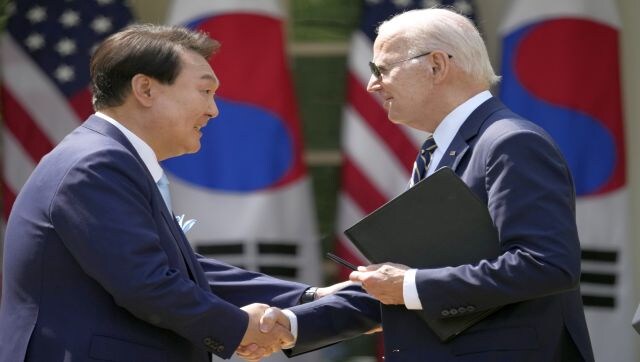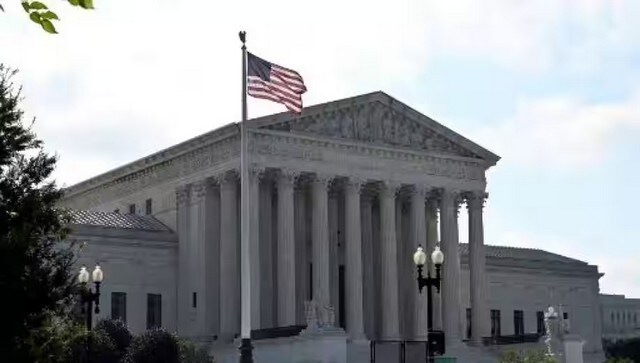Explained: Why is the US sending a nuclear submarine to South Korea?
Joe Biden and Yoon Suk-yeol announced the Washington Declaration from Rose Garden in the White House. This nuclear pact, which will see a US submarine docked in South Korea, has been designed to counter a rising threat from North Korea. But will it work as a deterrent?

As per the Washington Declaration, the US will send a nuclear-armed submarine to South Korea for the first time in 40 years, along with other strategic assets, including nuclear-capable bombers. File image/Reuters
Amid bonhomie and the music of Don McLean’s ‘American Pie’ ringing out loud in the White House, an important nuclear pact was signed between the United States and South Korea. Before South Korean president Yoon Suk-yeol sang the famous American song at a state dinner, he secured a landmark deal with US’ Joe Biden that would see the regular deployment of a nuclear submarine to Seoul.
The deal, called the “Washington Declaration,” is a series of initiatives designed to give Seoul more confidence that America would respond forcefully in the event of a nuclear strike by Pyongyang.
“A nuclear attack by North Korea against the United States or its allies or partners is unacceptable and will result in the end of whatever regime to take such an action,” said Joe Biden at the announcement of the Washington Declaration in the Rose Garden with Yoon.
Related Articles
Here’s a better look at why US and South Korea have inked this deal and how it affects the politics in the region.
What’s the Washington Declaration?
The Washington Declaration is a set of initiatives to counter the growing nuclear threat from North Korea with more aggressive rhetoric and a set of new deterrence measures.
It is well-known that Pyongyang has been building up its arsenal of tactical nuclear weapons with its leader Kim Jong-un urging his nuclear scientists to increase production of weapons-grade material. These weapons, according to experts, can target South Korea, posing an inherent threat to Seoul.
As per the Washington Declaration, the US will send a nuclear-armed submarine to South Korea for the first time in 40 years, along with other strategic assets, including nuclear-capable bombers. Interestingly, the last time a US submarine was in South Korean peninsula was in the 1970s during the Cold War. It was in 1991 that the US withdrew all of its nuclear weapons from the Korean Peninsula.
CNN reports that the submarine, which will deployed, will be the Ohio-class ‘boomer’ that has a displacement of more than 18,000 tonnes when submerged and powered by a single nuclear reactor.

The American navy said the submarine is designed to spend on average 77 days at sea, followed by 35 days in port for maintenance. When it comes to weaponry, each of these submarines carry a maximum of 20 Trident II ballistic missiles.
It has a range of 7,400 kilometres, meaning it has the capability of hitting a target in North Korea from vast swathes of the Pacific, Indian or Arctic oceans.
It’s important to note that President Joe Biden stressed that US nuclear weapons would not be stationed on South Korean territory.
Besides a deployment of a nuclear submarine, the Washington Declaration also sees the two sides developing a Nuclear Consultative Group to discuss nuclear planning issues. This means that the US will in future give Seoul more detailed insights into, and a voice in, US contingency planning to deter and respond to any nuclear threat in the region.
To simplify the matter – the US will give South Korea a louder voice in matter of nuclear activity in the region.
Biden and Yoon also announced efforts to step up training exercises and simulation activities to enhance preparation and coordination.

In return, South Korea will reaffirm its commitment to the Nuclear Non-proliferation Treaty, known as the NPT, which bars countries from developing their own nuclear weapons.
Biden pledged that any North Korean nuclear attack on the South “will be met with a swift, overwhelming and decisive response,” and that “the US commitment to extend deterrence to (South Korea) is backed by the full range of US capabilities, including nuclear.”
Yoon commenting on the pact said, “Sustainable peace on the Korean Peninsula does not happen automatically. Our two countries have agreed to immediate bilateral presidential consultations in the event of North Korea’s nuclear attack and promised to respond swiftly, overwhelmingly and decisively using the full force of the alliance, including the United States’ nuclear weapons.”
Tactical or symbolic: The benefits of this deal?
For South Korea, the Washington Declaration could be perceived as a win. This is because Seoul for a long time has been pushing Washington to involve them more in planning for how and when to use nuclear weapons against North Korea.
Duyeon Kim, from the Centre for a New American Security, was quoted as telling the BBC it was a “big win” for South Korea to be involved in nuclear planning. “Until now, tabletop exercises would end before Washington’s decision to use nuclear weapons,” said Kim.
“The US had considered such information to be too classified to share, but it is important to practice and train for this scenario given the types of nuclear weapons North Korea is producing.”
This deal ticks the box, providing the increased involvement the South Korean government has been asking for.
Leif-Eric Easley, a professor at Ewha University in Seoul, told AFP that the visit and the new deal undoubtedly “represents a new high-water mark for US-South Korea relations, with the breadth and depth of security, economic, and cultural cooperation on full display”.

It also helps Yoon back home, as he is dealing with a country that is increasingly nervous about US commitment to Seoul. In fact, a majority of South Koreans now believe the country should develop its own nuclear weapons, several surveys have revealed. Yoon had previously hinted Seoul could pursue this option.
When it comes to the nuclear submarine, most analysts believe that the move is more about symbolism. Some even counter that by placing a ballistic missile submarine in a South Korean port would reduce the military value of the sub.
“Tactically, (the US and South Korea) are diminishing the sub’s most powerful asset; its stealthiness,” Carl Schuster, a former US Navy captain and former director of operations at the US Pacific Command’s Joint Intelligence Center in Hawaii, told CNN.
What was the need for this deal?
The first and foremost reason for the Washington Declaration is the rapid advancement of North Korea’s nuclear programme. In 2022, Kim Jong-un’s kingdom carried out a whopping 68 tests, according to data from the James Martin Center for Nonproliferation Studies. This was 10 times more than in 2021.
And 2023 has been no different with Pyongyang continuing to carry out missile tests, making the world and South Korea, in particular, wonder is it just bombast or is the country preparing for an actual blast?
Also read: How powerful is North Korea really? A look at its military, missiles and nuclear weapons
North Korea has been ramping up its nuclear program and missile capabilities for the last six decades. However, in the past two years, the rhetoric has risen to a new high – the testing is more regular, often shooting projectiles into the ocean and warning its enemies that the next ones could be coming for them.
This has South Koreans on edge, with voices growing louder in the country for a nuclear deterrence. In March, two-thirds of South Koreans wanted their country to develop its own nuclear weapons, a recent survey from South Korean newspaper Hankook Ilbo revealed.
#VantageOnFirstpost: #SouthKorea is debating whether it should have nuclear weapons or not. So far, Seoul relied on US’ support. But can Washington be trusted anymore? South Korean President’s visit to the United States may have the answers. @Palkisu tells you more pic.twitter.com/gpPrTLFZkY
— Firstpost (@firstpost) April 24, 2023
This sentiment was also reflected in a 2022 survey from the Chicago Council on Global Affairs. A whopping 71 per cent of South Koreans wanted nuclear weapons. Choi Ji-young, a forum member and member of South Korea’s ruling People Power Party when speaking on the issue told BBC, “It is irrational to think another country should protect us. This is our problem and our responsibility.”
Apart from this, there’s also the constant threat of the Great Dragon, China, breathing fire in the region. Unsurprisingly, as Washington and Seoul announced the Washington Declaration, Beijing responded.
Its foreign ministry spokeswoman Mao Ning said, “All parties should face up to the crux of the (Korean) peninsula issue and play a constructive role in promoting a peaceful settlement of the issue.”
She added, “What the US is doing... provokes confrontation between camps, undermines the nuclear non-proliferation regime and the strategic interests of other countries.”
With inputs from agencies
Read all the Latest News, Trending News, Cricket News, Bollywood News,
India News and Entertainment News here. Follow us on Facebook, Twitter and Instagram.
also read

US Supreme Court to decide on access to mifepristone: What's at stake and what could happen next
At issue is the availability of mifepristone, part of a two-drug regimen that now accounts for more than half of the abortions in the United States. More than 5 million women have used mifepristone to terminate their pregnancies in the United States, and dozens of other countries have approved it

US debt ceiling crisis nears: How this could create turmoil in the financial world
The debt ceiling, also known as the debt limit, is the amount the United States can legally borrow to fulfill its financial obligations. A failure to raise the limit would see the US default – a nigh-unthinkable event that would csend financial markets into a tailspin

President Biden to host Philippines leader Ferdinand Marcos Jr amid growing tensions with China
The announcement to host Marcos Jr comes weeks after the US and the Philippines conducted the largest-ever joint military exercise in the disputed South China Sea in the face of China's growing assertiveness in the region


